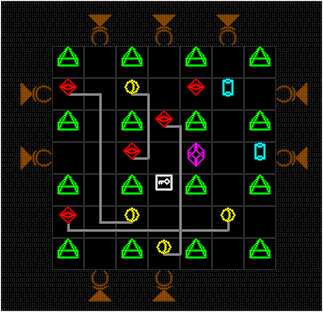Wednesday
Mar252009
Exploit: Hackers Unite!
 Wednesday, March 25, 2009 at 7:33PM
Wednesday, March 25, 2009 at 7:33PM I played through Exploit a few weeks ago. It's a great puzzle game that's pretty short and packed with a lot of charm. I just wanted to say a few quick things about the game.

- Making the only mechanic FIRE PACKET (clicking on the orange Ports) is a very smart way of simplifying and focusing the core design of the game. Even the most complex puzzles can be simplified by focusing on what the Ports can interact with first. By varying the number of Ports, the order they must be clicked, and the timing of the clicks, Weir had a lot of design room to work with.
- Though I prefer games to be as clean as possible where every element serves a functional purpose rather than just a cosmetic one, I have to make an exception for some of the elements in Exploit. As a computer hacker, there are times when you have to analyze a computer system and recognize what elements of that system are of no use to you. Likewise, in Exploit some levels contain Ports or other level elements that are extraneous and only serve as a distraction or to complete some kind of visual pattern like the level "Multicore" (image below). You can only hit one green Root Node.

- The story is quite whimsical and delivered entirely through a series of email like messages between levels. The lack of any real visuals on the characters, places, and events within the story create a kind of narrative distance that perfectly matches the remote anonymity of the internet. Just like in the story, you're just some genius hacker that agrees to play along in Sk3tch's scheme. Because you're a hacker operating by remote in the fiction, Exploit is a perfect game to play while sitting in front of your own computer. The abstract, puzzle solving gameplay really makes you feel like a hacker.

- The level design is quite excellent. Some are simple. Others whimsical. Others still are more challenging. Each of the game's 50 puzzles are very unique. All of this variability is possible because each of the level elements take up a unique design space. From Left to right, top to bottom, these level elements function as a goal (green), shooter (orange), blocker (red), splitter (purple), an unlocker (yellow), a revealer (blue), a temp blocker (light blue), and a shot creator (white).
- What pulls the level design together is how the levels are arranged in a 2D top down space. The packets that are fired from the orange Ports take time to travel across the screen. Some puzzles require player to fire their packets with careful timing, but the timing on most is pretty lenient. Comprehending an entire level requires the player to visualize straight lines from each Port that stretch across the level while understanding that these paths can change as you get closer to the goal. When I hacked a few advanced levels on my first try by tracing the little orange dots across the screen and reacting with the exact last second Port clicks I needed, I knew that the core design of Exploit was solid.
All the info is right before your eyes. It's up to you to see if you can hack it.
Well done Weir. Keep up the good work.


Reader Comments